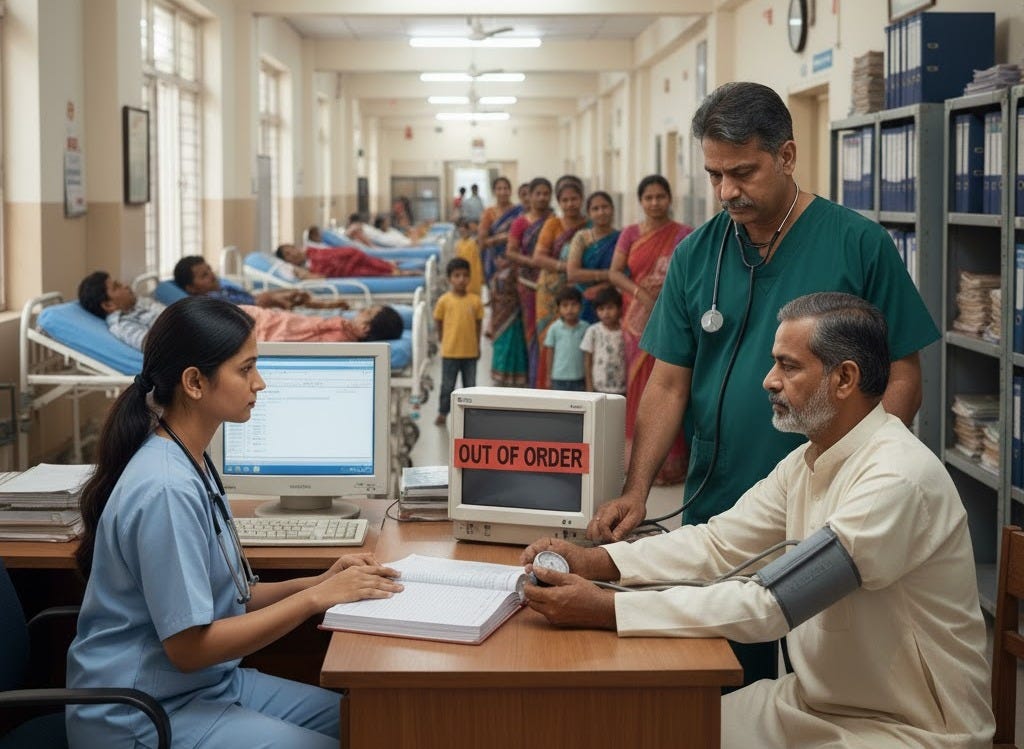A Doctor’s Field View: How Healthcare Policy Plays Out on the Ground
Firsthand insights reveal how India’s healthcare reforms unfold beyond the policy frame.
View as PDF
SDG 3: Good Health & Well-being
Institutions: Ministry of Health & Family Welfare
Dr Rakesh Thakur has spent nearly two decades in public service, moving between district hospitals and rural health camps across Himachal Pradesh. He describes his work as purposeful, yet often structurally constrained.
“Some days I feel like I am doing exactly what I trained for,” he says. “Other days, the system makes it harder to do the job than it needs to be.”
The tension between the intent of public service and the reality of its delivery is not unique. It reflects a broader pattern in how healthcare reforms have unfolded on the ground.
Infrastructure has expanded, and digital platforms have proliferated, yet challenges in upkeep and last-mile capability still persist. Rakesh’s account offers a close view of both the gains and the sticking points.
Facilities have Expanded, But Gaps in Functionality Remain
In recent years, India has substantially expanded its public health infrastructure. Over 1.5 lakh Health and Wellness Centres have been announced under the PM-Ayushman Bharat Health Infrastructure Mission (PM-ABHIM), alongside targeted investments in diagnostics and critical care.
One of the facilities where Rakesh had worked was among those newly upgraded.
“The building looked good in photos,” he notes. “But the ultrasound machine hadn’t worked for weeks. And during a surgery, the generator failed.”
In his experience, even where facilities are improved, inconsistent maintenance, staff shortages and procurement delays often render critical services non-functional. Patients may be referred to clinics 30-40 kilometres away for procedures that should have been available locally.
“People see the building,” he says. “But they don’t see the missing technician or the broken autoclave. You don’t feel proud in those moments. You just feel stuck.”
Digital Reforms are Promising, But Integration Remains Weak
Digitisation has been a central pillar of recent health reforms. The Ayushman Bharat Digital Mission (ABDM) aims to improve care continuity through integrated health records and more efficient referrals.
In practice, frontline systems remain fragmented. Rakesh estimates that for every hour spent with patients, he spends at least 30 minutes on paperwork, often repeating information across paper forms, portal entries, and messaging apps.
“The systems don’t talk to each other,” he explains. “Sometimes I fill in the same data three times, and the portal crashes before saving.”
A 2022 review in The Lancet Digital Health similarly found that Indian electronic health records are not yet integrated across levels of care, resulting in duplication and inefficiencies.
“I’m not against technology,” he adds. “But it should support the doctor–patient interaction, not dominate it. If the screen becomes more important than the person, something is off.”
While the intent is to reduce administrative burden, the design, bandwidth, and usability of digital tools often do not reflect the realities of rural or low-resource settings.
Frontline Workers Remain Undervalued, Despite Expanded Roles
Doctors may be the public face of the health system, but Rakesh is quick to highlight the contributions of others: Auxiliary Nurse Midwives (ANMs), Accredited Social Health Activists (ASHAs), lab technicians and pharmacists.
During COVID-19 vaccination drives, ASHAs in his block took on responsibilities ranging from outreach, registration and follow-up visits.
“They were the engine,” he says. “But they are underpaid, undertrained, and stretched across multiple programmes.”
Recognising their importance, the National Health Mission formally integrated community health workers into the system, and the 15th Finance Commission recommended greater investment in their training and compensation. Some states like Tamil Nadu and Rajasthan have followed through with institutionalised training cycles and performance-based incentives. In contrast, many others have yet to close the gap, with honoraria delayed, and workers remaining without formal upskilling pathways.
“If they feel supported, the system works better,” Rakesh says. “It’s not all on the doctor. It never was.”
In policy terms, these campaigns act as soft instruments -- As one ASHA worker put it:
“We don’t want praise. We want a phone that works and pay that comes on time.”
Policy Direction is Clear, But Delivery Still Falters
Rakesh has no plans to leave public service.
“This work matters,” he says. “The patients here don’t have a backup option.”
His account reflects a larger pattern. India’s policy architecture has advanced with expanded infrastructure, digital backbone, and formalised community roles. These are not cosmetic shifts; they signal a genuine commitment to public health. Yet delivery falters in the details - a broken scanner, a missed data upload, a delayed payment, a supervision chain that stalls.
Health systems are implemented in the day-to-day: in registers, ward rounds, coordination calls, and moments of patient care. Challenges persist, but so do signs of local improvisation and resilience: district teams borrowing supplies, facilities sharing staff, and frontline workers stretching beyond their mandate.
Rakesh’s experience is not a call for sweeping reform, but a reminder that effective policy depends on reliable, supported delivery. When systems are shaped by how they are experienced as well as how they are designed, far more becomes possible.
View as PDF
The name of the doctor in this article has been changed at his request. All other details are based on his account and have been approved for publication. This piece was prepared with assistance from Ms. Ananya Rathour, a member of the editorial team at The Policy Edge.


